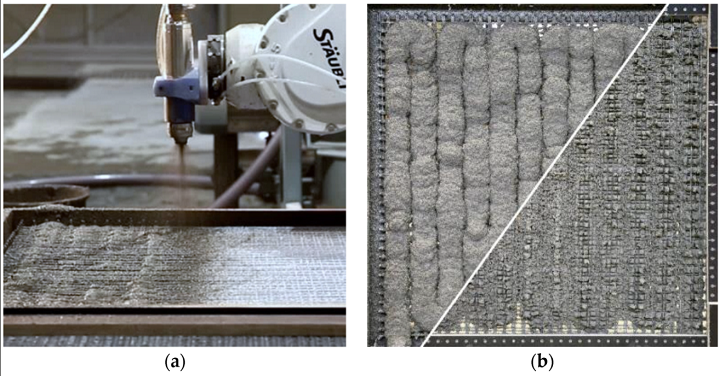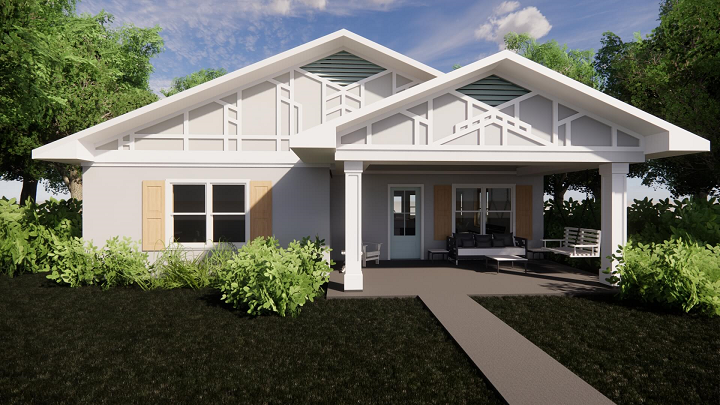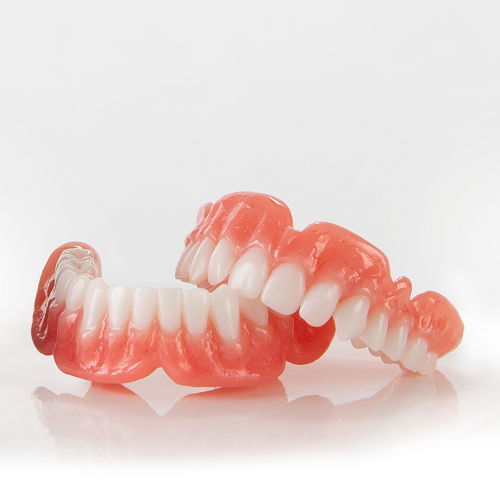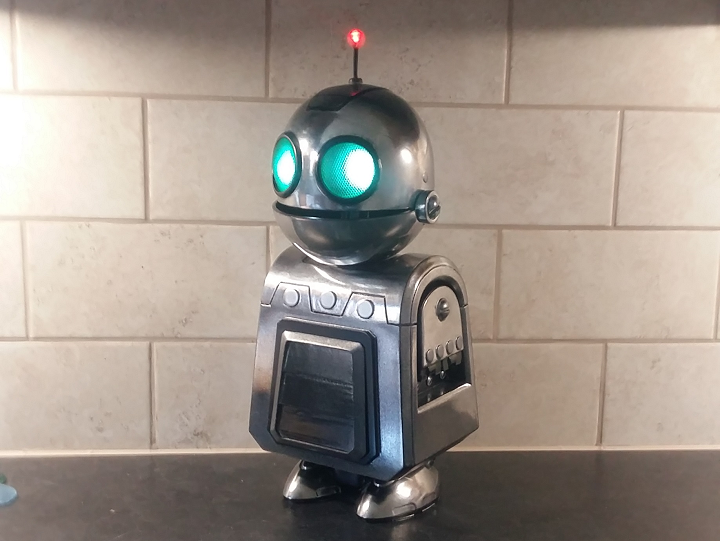3D Printing News Briefs, June 26, 2021: TU Braunschweig, Desktop Health, 9T Labs, Alfa Romeo & AM Solutions, Alquist & Virginia Tech, Creaform & USAF
In today’s 3D Printing News Briefs, we’re going over some interesting AM research, and then moving on to certifications, partnerships, military applications, and 3D printed video game characters. Read on for all the details!
Automated Integration of Textile Reinforcement for Concrete AM

Automated application of shotcrete (a) robotic shotcreting process; (b) first results of robotically shotcreting a winded reinforcement mesh (front and rear).
For a few years now, researchers at the Technische Universität Braunschweig have been working to develop an automated method for integrating textile reinforcement with concrete additive manufacturing, using the novel Shotcrete 3D Printing (SC3DP) method developed at the university, which not only extrudes the material but also sprays it with pressure to build a vertical 3D structure. Integrating structural reinforcement into 3D printed concrete components is a big challenge in the additive construction industry, and while a number of strategies are currently being investigated, such as manually inserting conventional steel reinforcement into a 3D printed lost formwork, simultaneous printing with wire arc additive manufacturing (WAAM) technology, injecting nails and screws to vertically connect layers, and more. TU Braunschweig researchers recently published another paper, “Development of a Robot-Based Multi-Directional Dynamic Fiber Winding Process for Additive Manufacturing Using Shotcrete 3D Printing,” about their continued work in this area.
“The research described in this paper is dedicated to the use of continuous fibers as reinforcement for additive manufacturing, particularly using Shotcrete,” the abstract explains. “Composites and in particular fiber reinforced polymers (FRP) are increasingly present in concrete reinforcement. Their corrosion resistance, high tensile strength, low weight, and high flexibility offer an interesting alternative to conventional steel reinforcement, especially with respect to their use in Concrete 3D Printing. This paper presents an initial development of a dynamic robot-based manufacturing process for FRP concrete reinforcement as an innovative way to increase shape freedom and efficiency in concrete construction. The focus here is on prefabricated fiber reinforcement, which is concreted in a subsequent additive process to produce load-bearing components. After the presentation of the fabrication concept for the integration of FRP reinforcement and the state of the art, a requirements analysis regarding the mechanical bonding behavior in concrete is carried out. This is followed by a description of the development of a dynamic fiber winding process and its integration into an automated production system for individualized fiber reinforcement. Next, initial tests for the automated application of concrete by means of Shotcrete 3D Printing are carried out. In addition, an outlook describes further technical development steps and provides an outline of advanced manufacturing concepts for additive concrete manufacturing with integrated fiber reinforcement.”
Desktop Health: Flexcera Dentures CE Mark Certification & Launch
A few months ago, Desktop Metal (NYSE: DM) launched a new division, called Desktop Health, which is, as you might expect, focused on bioprinting and AM solutions and advanced materials for personalized patient care and healthcare-adjacent 3D printed products. Recently the division announced that its proprietary resin, Flexcera Base, had received FDA 510(k) clearance, so it can be used to print dental prosthetics. Flexcera resin has the strength of ceramic, paired with long chain chemistry for optimal denture properties, and when used exclusively with EnvisionTEC printers, eight customized dentures can be printed, with moisture resistance to prevent discoloration and high fracture resistance, in less than two hours. Now, Desktop Health has revealed that its Flexcera resin has achieved CE Mark certification, which means that the proprietary materials meet the requirements of the European Medical Devices Directive—one step closer to launching the resins to dental professionals in the EU.
“The ability to deliver beautiful, high-quality, printable dental prosthetics is a powerful new capability made possible by Flexcera and Desktop Health. Until now, the production of dentures has been limited to milling methods which are time-consuming, or 3D printing methods which have been brittle. For the first time, with Flexcera, we now have a complete digital denture solution that delivers on the four cornerstones of what should be expected from 3D printing: strength, high aesthetics, accuracy and speed,” stated Prof. Patrik Zachrisson, Co-Founder and Vice President of the International Digital Dental Academy and a Partner Dentist at Digital Smile Studio in the United Kingdom.
Desktop Health’s Flexcera resin is expected to launch commercially in the US and Canada by the end of this month, and in Europe by the end of the summer.
9T Labs Receives Solar Impulse Approval for Red Series
9T Labs announced that its patented Red Series Additive Fusion Solution has been awarded the Solar Impulse Efficient Solutions label, which was developed by the Swiss environmental non-profit Solar Impulse Foundation. The non-profit, which was co-founded in 2003 in collaboration with the Federal Institute of Technology Lausanne (EPFL), is committed to speeding up the implementation of clean, profitable technology to make a positive impact on the environment and our quality of life, and it’s well-known for sponsoring the first completely solar-powered flight with experimental, long-range aircraft back in 2016. That same year, the Foundation announced the Solar Impulse Efficient Solutions program, with a goal of identifying 1,000 or more clean, profitable solutions from business startups that don’t compromise on economic growth and address environmental challenges—a goal it has since achieved.
The Red Series Additive Fusion Solution platform, with its hybrid manufacturing process of 3D printing and compression molding, allows for the affordable, rapid, and repeatable fabrication of carbon fiber-reinforced structural composite parts. It’s made up of a Build Module, which is a 3D printer that takes care of the fiber layup and preform production, and a Fusion Module, featuring a compact compression press that consolidates the preform and completes final part forming. The hybrid system, supported by 9T Labs’ Fibrify design suite, can produce high-performance structural parts, in small to medium-sized and thick sections, in production volumes from 100 to 10,000 parts per year, using high-performance thermoplastic composites like PA12 and PEKK. These parts could potentially replace metals in challenging environments, and can be made with high levels of R&R and very low amounts of waste.
Alfa Romeo Racing ORLEN Partners with AM Solutions
AM Solutions, a brand of surface finishing expert the Rösler Group, and Alfa Romeo Racing ORLEN are partnering together for the purposes of post-processing the F1 team’s 3D printed racecar innovations. The Alfa Romeo Racing ORLEN C41 car, which is racing in the 2021 Formula One World Championship, features several 3D printed parts, and with AM Solutions as a partner, the team will be able to ensure more efficient, precisely printed and finished parts. The company’s S1 system for automatic powder removal and cleaning, which is ideal for small to mid-size volumes of 3D printed parts, has plenty of handy features, including a specially developed wear protection lining made of non-staining anti-static polyurethane, a new basket design for optimal distribution and circulation of the parts, safe and ergonomic handling, and ATEX conformity.
“Additive manufacturing is playing an ever-increasing role in Formula One and every new iteration of our race cars feature more 3D printed parts – in addition to those used in other operations of the company, from the wind tunnel models to experimental parts,” said Frédéric Vasseur, Team Principal Alfa Romeo Racing ORLEN and CEO Sauber Motorsport AG.
“The innovations brought by AM Solutions help us create parts quickly, more efficiently and with less waste, meaning we gain on time and money, two resources available in very finite amounts in our sport, while at the same time improving the sustainability of our operations. It’s all part of the marginal gains we make across every aspect of our operations as we move towards the front of the grid.”
Alquist & Virginia Tech 3D Printing Single-Family Home

Alquist’s in-progress 3D-printed concrete home in Richmond, Virginia, features a porch swing and advanced smart home system developed by Virginia Tech. (Image courtesy Alquist)
The Virginia Center for Housing Research (VCHR) at Virginia Tech and additive construction company Alquist are working together on a new type of 3D printed home, and one they’re calling the first of its kind in the US: a 3D printed single-family home funded by a private-public partnership grant. Using the $500,000 Innovation Demonstration Grant from Virginia Housing, Alquist purchased the modular BOD2 construction 3D printer from COBOD, which can be set up and taken down again in just a few hours and only requires two trained construction works to operate; 3D printing can supposedly be complete in less than 15 hours. The team broke ground on the three-bedroom, 1,500 sq. ft. prototype home earlier this month, and it’s set to be finished in October. Alquist, which hopes to use this project as an example of the kind of low-cost housing that could be developed for rural communities across the country, is using a concrete mix to print the exterior walls only, which will help keep costs down. The university developed a proprietary Raspberry Pi-based smart home monitoring system, which includes a security and alarm system, emergency management, indoor environment sensing for things like humidity, lighting, and air quality, energy consumption optimization, and more.
“While most 3D printing endeavors focus on urban residential areas and commercial buildings, many of the regions facing the biggest housing challenges exist in rural America. That’s why we partnered with Virginia Housing and Virginia Tech to build homes for people who live outside of the places where most funding for housing programs is spent,” explained Zachary Mannheimer, the Founder and CEO of Alquist.
Additional project partners are general contractor RMT Construction & Development Group and local non-profits Project: HOMES and the Better Housing Coalition.
Using 3D Scanning in the Military
Obviously, aircraft are pretty useless if they’re not flightworthy, and the personnel responsible for upkeep are always on the lookout for more efficient ways to increase maintenance turnaround and reduce costs and risks. 3D scanning and measurement technology are very helpful in these scenarios, as they can be used to effectively provide CAD files for 3D printed replacement aircraft parts and prototypes, help to remedy user error discrepancies, and allow for quicker MRO and reverse engineering operations, which then improves mission effectiveness. One such tool is the Creaform handheld HandySCAN 3D scanner, which was used at the 366th Maintenance Squadron (MXS) at Mountain Home Air Force Base (MHAFB) in Idaho to quickly scan large aircraft structures, rather than using facsimile molds for reverse engineering. Fairfield, California’s Travis AFB, via the 60th MXS, also uses the HandySCAN, in addition to the SmartDENT 3D and onsite 3D printers, to help replace damaged aircraft parts, thanks to funds allocated by the Air Force to Squadron Innovation Funds. Once, a C-5 aircraft was damaged by hail, and using Creaform’s HandySCAN AEROPACK, Travis Airmen were able inspect the aircraft to locate and measure the dents on the surface of the wings in just 30 minutes.
Master Sgt. Christopher Smithling, 60th MXS Assistant Section Chief for Aircraft Structural Maintenance, said, “We had that C-5 in our hangar last week and we were able to inspect the four primary structural panels in 30 minutes.
“With the two additive manufacturing units, we will be able to grab any aircraft part, scan it, and within four to eight hours, we will have a true 3D drawing of it that we can send to the additive manufacturing unit to print it.”
3D Printed Ratchet and Clank: Rift Apart Character
Ending things on a fun note, the Insomniac Games’ Ratchet and Clank: Rift Apart video game for PlayStation 5 recently launched, and a fan celebrated the arrival with a cool, extremely detailed 3D printed version of the robot character Clank, which he’s been working on for months. Twitter user Tom Lacey used Blender to create the model, which hasn’t changed much over the years, and printed the robot with a Creality CR-10 S4 3D printer. He used a clear resin print and honeycomb pattern to get the character’s huge eyes right, and the 3D printed Clank does appear to have a moveable head and mouth. Lacey had to spend a long time sanding down the various parts of Clank, and then filled it using a spray putty, before airbrushing it with mainly Alclad chrome paint. The results are pretty amazing!
✨CLANK’S FINALLY FINISHED✨
After many loooong months of printing, sanding and painting he’s finally done! Man this took way longer than I’d hoped haha 😅Hope you don’t mind me tagging a few people 🥺👉👈#RiftApart #RatchetPS5 #3Dprinting #RatchetAndClankPS5 pic.twitter.com/4AzhZeY16u
— Tom Lacey (@HappyMoonInc) June 8, 2021
Subscribe to Our Email Newsletter
Stay up-to-date on all the latest news from the 3D printing industry and receive information and offers from third party vendors.
You May Also Like
High Stakes, High Speed: KVG Acquires 15 Nexa3D HSE 3D Printers to Boost Military Tech
As 3D printing increasingly intersects with defense and military logistics, a new partnership between Nexa3D and mission support logistics firm KVG stresses the growing importance of this technology in strategic...
3D Printer Maker EVO-tech Reborn as NEVO3D — Once More With Feeling
EVO-tech was a 3D printing service and original equipment manufacturer established in 2013 and based in Schörfling am Attersee, Austria. The company produced high-quality material extrusion systems featuring linear bearings,...
3D Printing News Briefs, March 16, 2024: Partnerships, Affordable Bioprinter, & More
We’re starting with dental 3D printing news today, and then moving on to some new partnerships. Then it’s on to some interesting university research about 3D printing plant-based pharmaceuticals, but...
FDR vs. SLA: The Right Polymer Manufacturing Choice for Your Application
The additive manufacturing (AM) industry has no shortage of acronyms when it comes to the various methodologies of industrial 3D printing. In polymer 3D printing, there are three main methods...




































